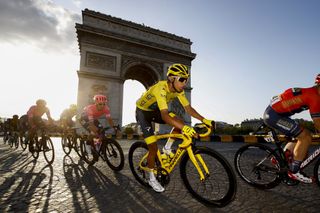Zwift build new Mont Ventoux and Champs Elysées worlds for virtual Tour de France
Details of route and team format emerge for July virtual racing

Professional riders will race on a virtual Mont Ventoux and Champs Elysées next month as Zwift builds new worlds for an online Tour de France.
As revealed by Cyclingnews earlier this month, Tour de France organisers ASO have partnered with Zwift to hold a virtual Grande Boucle for both men and women during July. The eSports racing will take place during three weekends during the Tour’s original dates, with men’s and women’s races consisting of six stages and taking place between July 4 – 19.
More details have now emerged, with four of the six stages to take place on a new Zwift world named France. Stage 5, the penultimate stage, on July 18, will be the queen stage with a finish at Chalet Reynard, the point half-way up Mont Ventoux where the road emerges from the trees and opens out onto the exposed mountainside.
The stage is 22.9km long, with the climb to Chalet Reynard from Bedoin measuring 15km with an average gradient of 7.5 per cent.
The following day, the virtual Tour de France will emulate the finale of the real event with a stage on Paris’ Champs Elyséees.
The riders will cover six laps of the 6.6km circuit that rises gently up to the Arc du Triomphe and then back down to the Tuileries Gardens, with smart trainers now able to mimic the cobbled surface.
The first two take place in Zwift’s flagship Watopia world, the first on the reverse of the ‘Hilly’ route, with four laps of the 9.1km circuit, and the second on the ‘Mountain’ route, a 29.5km course that features 682m of elevation gain.
Get The Leadout Newsletter
The latest race content, interviews, features, reviews and expert buying guides, direct to your inbox!
The second weekend of action (July 11-12) sees the race leave Watopia for the new France world.
Stage 3 takes place on a route named R.G.V, with two laps of the largely flat 24km circuit, while stage 4 is on a route named ‘Casse Patte’, a French term meaning 'leg-breaking', or an undulating parcours that gives little respite. The riders will complete two laps of the 22.9km circuit for a total elevation of 310m.
The race concludes on the weekend of July 18-19 – the original final weekend – with the Ventoux stage and the Paris finale.
The format
The virtual Tour de France will feature a yellow jersey but there will not be an individual general classification. Instead, like the recent Zwift Tour For All, it is based on a team competition where riders win points across stage finishes, KOMs, and sprints.
The virtual yellow jersey will be worn by the rider the leading team nominates as captain for the subsequent stage, with teams allowed to choose different riders for each stage. Points for the yellow jersey standings – or GC – are awarded for the first 25 riders on each stage, with 50 for the winer.
As in the Tour de France, there’s a polka-dot jersey for the mountains classification, a green jersey for the points classification, a white jersey for best young rider and a most combative award.
For the polka-dot and green jerseys, points are issued atop the climbs and at intermediate and finish-line sprints, respectively, with the team that has the highest combined total able to nominate a rider to wear the jersey. Only one rider per team can score points for the young rider classification, with teams obliged to field at least one rider under the age of 25. There is no jersey for most combative but three riders on each stage score points.
The points for all the classifications are then combined to decide the teams classification.
Cyclingnews understands that at least 15 teams have so far signed up, while 10 television channels covering 130 countries are have signed up to broadcast the event.
The real Tour de France is still set to go ahead on its new dates of August 29-September 20, starting in Nice with a road race stage.
Patrick is a freelance sports writer and editor. He’s an NCTJ-accredited journalist with a bachelor’s degree in modern languages (French and Spanish). Patrick worked full-time at Cyclingnews for eight years between 2015 and 2023, latterly as Deputy Editor.
